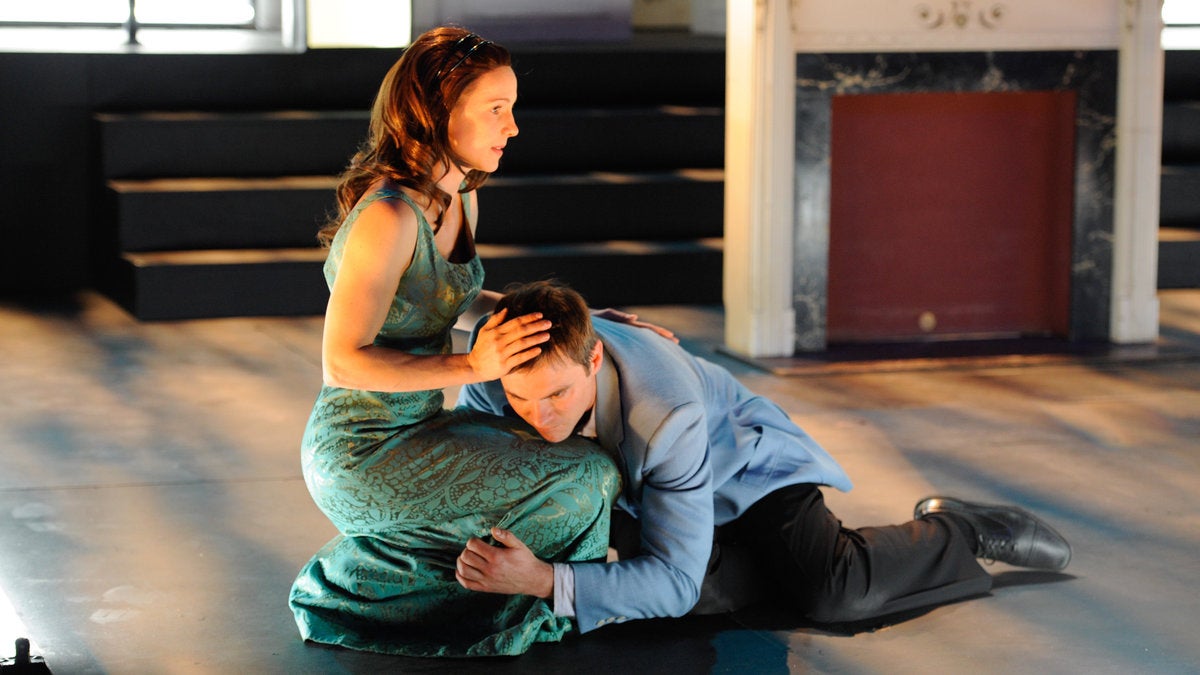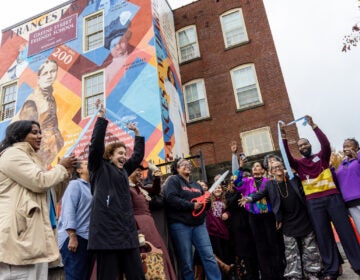Review: In full glory, ‘Mourning Becomes Electra’

Mattie Hawkinson and Josh Carpenter as tormented siblings in Quintessence Theatre Group's production of "Mourning Becomes Electra." (Photo courtesy of Shawn May)
Congratulations to Quintessence Theatre Group for producing Eugene O’Neill’s “Mourning Becomes Electra,” a bold undertaking and a risky one, too. I can’t remember a professional production of the play here until this one – it’s a work as demanding of an audience’s patience for the sheer time it takes as it is of a theater company’s endurance for the raw energy it demands. The play clocks in at four hours, 35 minutes at Quintessence.
In this case, congratulating Quintessence for simply producing O’Neill in all of “Mourning’s” glory would be patronizing – I could have done that last year, when the stage company announced the play as a part of this season. The real hat-tip goes to the production itself, a piece whose cast builds its characters steadily and surely, is unafraid of the transparent melodrama that O’Neill used to his advantage, and understands how to finesse the messiness of a plot that turns on dimes throughout its full dollar’s worth of time.
Quintessence’s artistic director Alexander Burns stages it with grand movement, giving us the sense that we’re not just seeing a classic – performing the classics is Quintessence’s mission – but that we’re seeing a special one. I don’t regard the play with the level of respect some people give it, as an unmatchable milestone in American theater. It’s a boisterous and somewhat repetitive mix of poetic playwriting amid the necessary nuts and bolts. It’s clearly exploring some Big Ideas, and you can never be sure just what they are. Fate? The actions of humans that negate the notion of fate? At Quintessence, it is most of all a great story, largely because it has a fine cast that thoughtfully, methodically, and passionately tells it.
In 1931, “Mourning Becomes Electra” hit Broadway, ran 150 performances, then was revived 42 years ago. It’s never been revived there since. But the tale has a far longer history than this. It premiered in its original form 2,472 years ago in a work by Aeschylus, called “The Oresteia” — a trilogy involving the way the gods play with fate, the way people intervene, and how murderers kill pieces of themselves even as they kill others. Well, that last part is not direct plot, but the philosophical underpinning.
“The Orestia” won the Dionysia, the theater festival in Athens, for which it was produced. (Sort of like getting the best-play Tony Award, only only much more celebrated and much less of a marketing idea.) Fast forward to millennia later, and Eugene O’Neill gives himself a daunting challenge: take “The Oresteia,” give it a modern setting – he chose 19th- century New England – and translate all the characters as Americans we would relate to in the same story. He also decides to maintain the triology form.
In the Quintessence production, each part is set in a different post-war period – first, as the Civil War ends (O’Neill’s setting), then after World War II, and finally, after the Korean War. We sense these changes from Jane Casanave’s stellar costumes and in the era-shifting original music of Steven Cahill. Both work nicely in the confines of the play but really, if you don’t know what Quintessence is aiming for, you’ll neither catch the differences nor be confused by them. They are essentially meaningless conceits in a play that gives us enough to chew on without needing shifts in the nutrients.
Quintessence produces “Mourning Becomes Electra” pretty much as it was written – the original had a coterie of townspeople, a gossiping chorus about the once-revered Mannon family, whose tribulations and gradual downfall O’Neill charts. Getting rid of the chorus is a modern necessity – the cast would be enormous in a play that’s already a whopping undertaking. The result is that we hear throughout about the gossip in the town, but never actually hear the gossip. Given that the gossip is a strong motivation for the family to cover up its crimes against each other, we have to buy cause-and-effect on faith.
In the long view – and that’s the sort of view that the sprawling “Mourning Becomes Electra” demands – these are quibbles. The play that Quintessence presents is a grand display, even grander when you consider that this is only the fourth season for the company, which performs at a movie theater called the Sedgwick in Mount Airy. Quintessence is a repertory troupe of professional actors (increasingly rare these days). The company keeps its focus on performing the classics with and without theatrical twists, and has quickly come to provide colorful fireworks in the city’s exploding theater scene.
This particular display – you have only the weekend remaining to see it – boasts the estimable Janis Dardaris as the conniving, lying mother of this clan. Dardaris takes Christine, a character who’s extreme, and plays her for real; astonishingly, the larger-than-life she becomes, the more real she seems. Christine adores her son, who pays her back in kind, and she’s madly in love with a young man who turns out to be her nephew, the son of her long-disgraced brother in law who was banished from the family. She despises her husband (the excellent Robert Jason Jackson) and has no feeling at all for her daughter.
That daughter is Lavinia – the Electra of the Greek version, who adores her dad and finds her mother abhorrent, but eventually becomes a plotter and liar just like mom. Murder and death are the morbid engines that drive this epic; guilt and the ability to rationalize just about anything provide the fuel.
Mattie Hawkinson plays Lavinia – at first, too transparently, but as the plays moves along, she invests the role with the sort of magnificence it requires. In the end, she has fully inhabited it. As her brother, Josh Carpenter devolves from sanity to a murderous, guilt-wracked conniver in a memorable performance that’s alternately menacing and affecting. Andrew Breving, Erin Mulgrew, Terence Gleeson and Alan Brincks round out the cast with style.
The careful lighting by John Burkland is essential in the Mannon house, where darkness seems to invade in ever-eerier ways. And, hooray, Quintessence is performing “Mourning Becomes Electra” with a full set, something the company has not always been able to budget. It’s designed by Burns, Quintessence’s leader, and its main feature is a handsome display of the Mannon mansion façade, complete with vertical lights that to the outside world, belie the darkness within.
_“Mourning Becomes Electra,” produced by Quintessence Theatre Group, runs through April 27 at the Sedgwick Theater, Germantown Avenue between Durham Street and Mount Airy Avenue. 215-987-4450 or www.quintessencetheatre.org.
WHYY is your source for fact-based, in-depth journalism and information. As a nonprofit organization, we rely on financial support from readers like you. Please give today.




